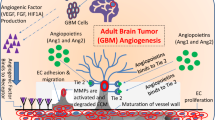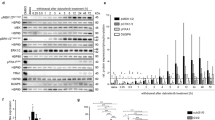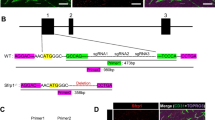Abstract
Invasion is a hallmark of malignant gliomas and is the main reason for therapeutic failure and recurrence of the tumor. CXCR4 is a key chemokine receptor implicated in glioma cell migration whose expression is regulated by hypoxia. Here, we report that hepatocyte growth factor (HGF) upregulated CXCR4 protein expression in glioma cells. HGF pre-treatment increased migration of U87MG and LN229 glioma cells towards the CXCR4 ligand, stromal cell-derived factor-1α (SDF-1α). AMD3100, a CXCR4 inhibitor, inhibited the increased migration of HGF pre-treated LN229 glioma cells towards SDF-1α. Following exposure to HGF and hypoxia, both cell lines showed nuclear translocation of NF-κB (p65). The HGF- and hypoxia-induced nuclear translocation of NF-κB (p65) involved phosphorylation and degradation of IκB-α. Knock-down of NF-κB expression inhibited the induction of CXCR4 expression in response to HGF, but not to hypoxia. However, knock-down of NF-κB expression inhibited the induction of CXCR4 expression in response to hypoxia in the presence of HGF. NF-κB mediated migration towards SDF-1α in response to HGF. Knock-down of NF-κB expression resulted in decreased migration of HGF pre-treated glioma cells towards SDF-1α. Therefore, HGF upregulates CXCR4 expression via NF-κB and leads to enhanced migration. To our knowledge, this is the first report to show that a crosstalk mediated by NF-κB exists between the SDF-1α/CXCR4 and HGF/c-Met axes relevant to glioma cell migration. These findings imply that effective inhibition of glioma invasion should be directed against several ligand/receptor signaling pathways.





Similar content being viewed by others
Abbreviations
- HGF:
-
Hepatocyte growth factor
- SDF-1α:
-
Stromal cell-derived factor-1α
References
Mueller MM, Werbowetski T, Del Maestro RF (2003) Soluble factors involved in glioma invasion. Acta Neurochir 145:999–1008
Zagzag D, Esencay M, Mendez O et al (2008) Hypoxia- and vascular endothelial growth factor-induced stromal cell-derived factor-1alpha/CXCR4 expression in glioblastomas: one plausible explanation of Scherer’s structures. Am J Pathol 173:545–560
Giese A, Bjerkvig R, Berens ME et al (2003) Cost of migration: invasion of malignant gliomas and implications for treatment. J Clin Oncol 21:1624–1636
Rempel SA, Dudas S, Ge S et al (2000) Identification and localization of the cytokine SDF1 and its receptor, CXC chemokine receptor 4, to regions of necrosis and angiogenesis in human glioblastoma. Clin Cancer Res 6:102–111
Muller A, Homey B, Soto H et al (2001) Involvement of chemokine receptors in breast cancer metastasis. Nature 410:50–56
Scotton CJ, Wilson JL, Scott K et al (2002) Multiple actions of the chemokine CXCL12 on epithelial tumor cells in human ovarian cancer. Cancer Res 62:5930–5938
Su L, Zhang J, Xu H et al (2005) Differential expression of CXCR4 is associated with the metastatic potential of human non-small cell lung cancer cells. Clin Cancer Res 11:8273–8280
Darash-Yahana M, Pikarsky E, Abramovitch R et al (2004) Role of high expression levels of CXCR4 in tumor growth, vascularization, and metastasis. FASEB J 18:1240–1242
Pan J, Mestas J, Burdick MD et al (2006) Stromal derived factor-1 (SDF-1/CXCL12) and CXCR4 in renal cell carcinoma metastasis. Mol Cancer 5:50–56
Zagzag D, Lukyanov Y, Lan L et al (2006) Hypoxia-inducible factor 1 and VEGF upregulate CXCR4 in glioblastoma: implications for angiogenesis and glioma cell invasion. Lab Invest 86:1221–1232
Zhou Y, Larsen PH, Hao C et al (2002) CXCR4 is a major chemokine receptor on glioma cells and mediates their survival. J Biol Chem 277:49481–49487
Wu M, Chen Q, Li D et al (2008) LRRC4 inhibits human glioblastoma cells proliferation, invasion, and proMMP-2 activation by reducing SDF-1 alpha/CXCR4-mediated ERK1/2 and Akt signaling pathways. J Cell Biochem 103:245–255
Zhang J, Sarkar S, Yong VW (2005) The chemokine stromal cell derived factor-1 (CXCL12) promotes glioma invasiveness through MT2-matrix metalloproteinase. Carcinogenesis 26:2069–2077
Masuya D, Huang C, Liu D et al (2004) The tumour-stromal interaction between intratumoral c-Met and stromal hepatocyte growth factor associated with tumour growth and prognosis in non-small-cell lung cancer patients. Br J Cancer 90:1555–1562
Fujiuchi Y, Nagakawa O, Murakami K et al (2003) Effect of hepatocyte growth factor on invasion of prostate cancer cell lines. Oncol Rep 10:1001–1006
Hara S, Nakashiro K, Klosek SK et al (2006) Hypoxia enhances c-Met/HGF receptor expression and signaling by activating HIF-1alpha in human salivary gland cancer cells. Oral Oncol 42:593–598
Martin TA, Parr C, Davies G et al (2003) Growth and angiogenesis of human breast cancer in a nude mouse tumour model is reduced by NK4, a HGF/SF antagonist. Carcinogenesis 24:1317–1323
Miura Y, Kozuki Y, Yagasaki K (2003) Potentiation of invasive activity of hepatoma cells by reactive oxygen species is mediated by autocrine/paracrine loop of hepatocyte growth factor. Biochem Biophys Res Commun 305:160–165
Abounader R, Laterra J (2005) Scatter factor/hepatocyte growth factor in brain tumor growth and angiogenesis. Neuro Oncol 7:436–451
Brockmann MA, Ulbricht U, Gruner K et al (2003) Glioblastoma and cerebral microvascular endothelial cell migration in response to tumor-associated growth factors. Neurosurgery 52:1391–1399 (discussion 9)
Burgess T, Coxon A, Meyer S et al (2006) Fully human monoclonal antibodies to hepatocyte growth factor with therapeutic potential against hepatocyte growth factor/c-Met-dependent human tumors. Cancer Res 66:1721–1729
Eckerich C, Zapf S, Fillbrandt R et al (2007) Hypoxia can induce c-Met expression in glioma cells and enhance SF/HGF-induced cell migration. Int J Cancer 121:276–283
Matteucci E, Locati M, Desiderio MA (2005) Hepatocyte growth factor enhances CXCR4 expression favoring breast cancer cell invasiveness. Exp Cell Res 310:176–185
Vermeulen L, De Wilde G, Notebaert S (2002) Regulation of the transcriptional activity of the nuclear factor-κB p65 subunit. Biochem Pharmacol 64:963–970
Helbig G, Christopherson KW II, Bhat-Nakshatri P et al (2003) NF-kappaB promotes breast cancer cell migration and metastasis by inducing the expression of the chemokine receptor CXCR4. J Biol Chem 278:21631–21638
Raychaudhuri B, Han Y, Lu T et al (2007) Aberrant constitutive activation of nuclear factor kappaB in glioblastoma multiforme drives invasive phenotype. J Neurooncol 85:39–47
Fujiwara S, Nakagawa K, Harada H et al (2007) Silencing hypoxia-inducible factor-1alpha inhibits cell migration and invasion under hypoxic environment in malignant gliomas. Int J Oncol 30:793–802
Pennacchietti S, Michieli P, Galluzzo M et al (2003) Hypoxia promotes invasive growth by transcriptional activation of the met protooncogene. Cancer Cell 3:347–361
Tu H, Zhou Z, Liang Q et al (2009) SDF-1 and CXCR4 production are stimulated by hepatocyte growth factor and promote glioma cell invasion. Onkologie 32:331–336
Li L, Gondi CS, Dinh DH et al (2007) Transfection with anti-p65 intrabody suppresses invasion and angiogenesis in glioma cells by blocking nuclear factor-kappaB transcriptional activity. Clin Cancer Res 13:2178–2190
Maroni P, Bendinelli P, Matteucci E et al (2007) HGF induces CXCR4 and CXCL12-mediated tumor invasion through Ets1 and NF-kappaB. Carcinogenesis 28:267–279
Cummins EP, Comerford KM, Scholz C et al (2007) Hypoxic regulation of NF-kappaB signaling. Methods Enzymol 435:479–492
Park MH, Ahn BH, Hong YK et al (2009) Overexpression of phospholipase D enhances matrix metalloproteinase-2 expression and glioma cell invasion via protein kinase C and protein kinase A/NF-kappaB/Sp1-mediated signaling pathways. Carcinogenesis 30:356–365
Sahin A, Vercamer C, Kaminski A et al (2009) Dominant-negative inhibition of Ets 1 suppresses tumor growth, invasion and migration in rat C6 glioma cells and reveals differentially expressed Ets 1 target genes. Int J Oncol 34:377–389
Kunkel P, Muller S, Schirmacher P et al (2001) Expression and localization of scatter factor/hepatocyte growth factor in human astrocytomas. Neuro Oncol 3:82–88
Acknowledgments
This work was supported by the National Institutes of Health grant R01 CA100426.
Author information
Authors and Affiliations
Corresponding author
Rights and permissions
About this article
Cite this article
Esencay, M., Newcomb, E.W. & Zagzag, D. HGF upregulates CXCR4 expression in gliomas via NF-κB: implications for glioma cell migration. J Neurooncol 99, 33–40 (2010). https://doi.org/10.1007/s11060-010-0111-2
Received:
Accepted:
Published:
Issue Date:
DOI: https://doi.org/10.1007/s11060-010-0111-2




